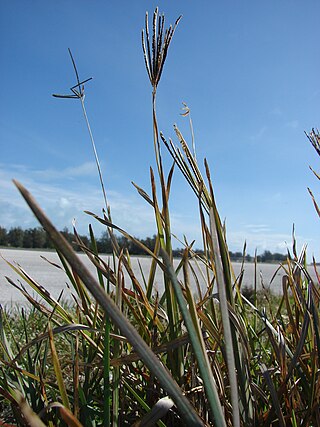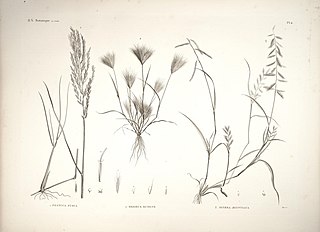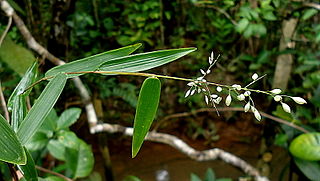
Poa flabellata, commonly known as tussac grass or just tussac, is a tussock grass native to southern South America, the Falkland Islands, South Georgia and other islands in the South Atlantic. There are also two isolated records from the herbarium at the French Muséum national d'histoire naturelle for the Île Amsterdam in the Indian Ocean.

Eustachys is a genus of tropical and subtropical plants in the grass family. It is native primarily to warmer parts of the Americas, with a few species in Africa and Asia.
Anthaenantiopsis is a genus of South American plants in the grass family.
Streptostachys is a genus of South American plants in the grass family.
Triniochloa is a genus of Latin American plants in the grass family.

Dinebra is a genus of Asian, African, and Pacific Island plants in the grass family.
Oplismenopsis is a genus of South American plants in the grass family. The only known species is Oplismenopsis najada, native to southern Brazil, Uruguay, and northeastern Argentina.

Parodiolyra is a genus of Neotropical plants in the grass family.
- Parodiolyra aratitiyopensisJ.R.Grande - Venezuela (Amazonas)
- Parodiolyra colombiensisDavidse & Zuloaga - Colombia (Caquetá)
- Parodiolyra lateralis(J.Presl ex Nees) Soderstr. & Zuloaga - Nicaragua, Costa Rica, Panama, Colombia, Venezuela, Guyana, Suriname, Ecuador, Peru, Brazil
- Parodiolyra luetzelburgii(Pilg.) Soderstr. & Zuloaga - Brazil, Colombia, Venezuela, Guyana, Suriname, French Guiana
- Parodiolyra micrantha(Kunth) Davidse & Zuloaga - Brazil, Colombia, Venezuela, Guyana, Suriname, French Guiana, Peru, Bolivia, Argentina, Paraguay
- Parodiolyra ramosissima(Trin.) Soderstr. & Zuloaga - Brazil (Bahia)
Gerritea is a genus of Bolivian plants in the family Poaceae. The only known species is Gerritea pseudopetiolata, native to La Paz Department in Bolivia.

Acmella uliginosa, the marsh para cress, is a species of flowering herb in the family Asteraceae. The plant is native to South America and is naturalized in parts of Asia and Africa.

Anthaenantia is a New World genus of plants in the grass family, native to North and South America including the West Indies. The genus name is sometimes spelled Anthenanthia or Anthenantia.
Altoparadisium is a genus of bunchgrass plants in the grass family. The species are native to Brazil and Bolivia in South America.
Brickellia diffusa is a Latin American species of flowering plants in the family Asteraceae. It is widespread across much of South America, Central America, Mexico, Galápagos, and the West Indies. Its distribution stretches from Sonora and Tamaulipas in northern Mexico to Jujuy in northern Argentina.
Chromolaena hirsuta is a South American species of flowering shrub in the family Asteraceae. It is native to Brazil, Bolivia, Uruguay, and Argentina.

Persicaria hydropiperoides is a New World species of flowering plant in the buckwheat family known by the common names swamp smartweed and false waterpepper. It is widespread across much of North America and South America. It grows in moist and wet habitats, and is sometimes semi-aquatic.
Hypochaeris microcephala, the smallhead cat's ear, is a species of plants in the tribe Cichorieae within the family Asteraceae. It is native to South America and naturalized in parts of North America.
Rubus glabratus is a Latin American species of brambles in the rose family. It is native to Central America and South America.

Xyris jupicai, common name Richard's yelloweyed grass, is a New World species of flowering plants in the yellow-eyed-grass family. It is widespread in North America, South America, Mesoamerica, and the West Indies.
Xyris asperula is an uncommon South American species of flowering plants in the yellow-eyed-grass family. It has been found in Bolivia and also in the States of Goiás and Minas Gerais in Brazil.

Dr. Charlotte M. Taylor is a botanist and professor specialising in taxonomy and conservation. She works with the large plant family Rubiaceae, particularly found in the American tropics and in the tribes Palicoureeae and Psychotrieae. This plant family is an economically important group, as it includes plant species used to make coffee and quinine. Taylor also conducts work related to the floristics of Rubiaceae and morphological radiations of the group. Taylor has collected plant samples from many countries across the globe, including Chile, Colombia, Costa Rica, Panama, and the United States of America, and has named many new species known to science from these regions. As of 2015, Taylor has authored 278 land plant species' names, the seventh-highest number of such names authored by any female scientist.









